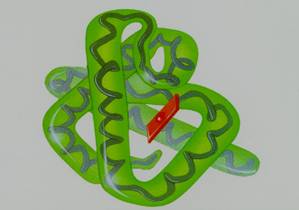structures of proteins
If a lot of amino acids make a polypeptide, than the long chain will start to fold / roll on into certain structures.
In the first place a so called Helix is formed, it will screw up and we name that the secondary structure of the proteins.
The primary structure is simply the sequence of the amino acids.
The Helix, in its turn, can be folded again and form a tridimensional structure that we call the tertiary protein structure. (see figure)

Have a good look at the image and try to see / to indicate the secondary and the tertiary structures, and the active spot (the co-enzyme) of the enzyme.
The L-amino acids are the building stones of the proteins; they form the peptide bonds and are responsible for the Helices.
The primary structure of the proteins
So the sequence of amino acids in the polypeptides, in the proteins, we call the primary structure. It is the linear sequence of the amino acids.
This sequence is extremely important for the functioning of that particular protein. Substitution of one amino acid can be enough to change completely the activity of that protein in the organism, maybe with very negative consequences.

figure: albumine,
The sequence of the amino acids and the positions of the S-bridges.
A protein molecule can be composed out of one or more polypeptides.
The amino acid Proline, if it appears somewhere in a polypeptide chain, forbids or disturbs the formation of α-helices.
The consequence is: no Hydrogen bridges can be formed (because of lack of the necessary polarity).
The secondary structure of proteins
The polypeptide chains will curl as a screw: a helix. This is the secondary structure.
Tertiary structure of proteins
A long polypeptide chain with a helix, still can be very long and fold in a threedimensional way: the tertiary structure.
Quaternary structure of proteins
The very large protein molecules are composed of more tertiary spheres: quaternary structure.

